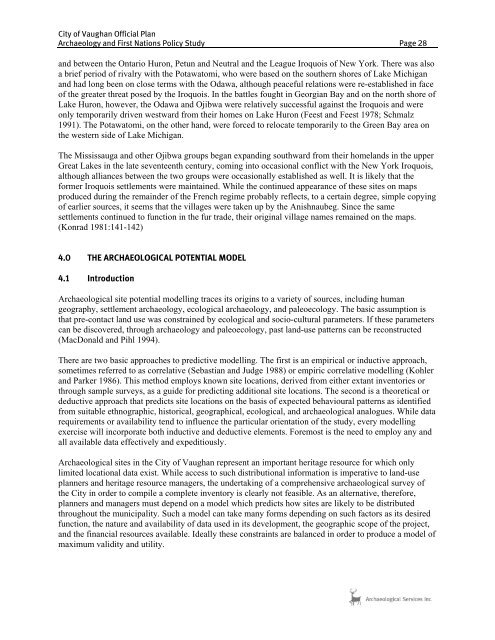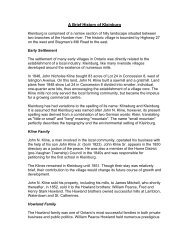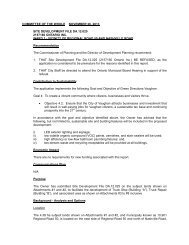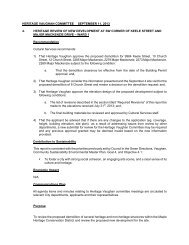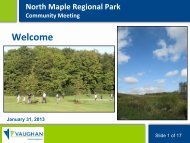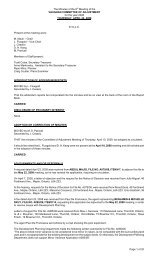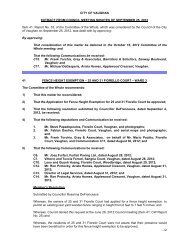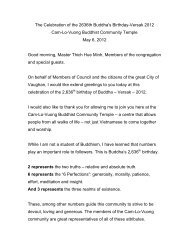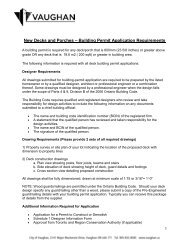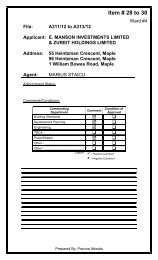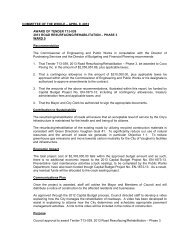The Archaeological Potential Model - City of Vaughan
The Archaeological Potential Model - City of Vaughan
The Archaeological Potential Model - City of Vaughan
You also want an ePaper? Increase the reach of your titles
YUMPU automatically turns print PDFs into web optimized ePapers that Google loves.
<strong>City</strong> <strong>of</strong> <strong>Vaughan</strong> Official Plan<br />
Archaeology and First Nations Policy Study Page 28<br />
and between the Ontario Huron, Petun and Neutral and the League Iroquois <strong>of</strong> New York. <strong>The</strong>re was also<br />
a brief period <strong>of</strong> rivalry with the Potawatomi, who were based on the southern shores <strong>of</strong> Lake Michigan<br />
and had long been on close terms with the Odawa, although peaceful relations were re-established in face<br />
<strong>of</strong> the greater threat posed by the Iroquois. In the battles fought in Georgian Bay and on the north shore <strong>of</strong><br />
Lake Huron, however, the Odawa and Ojibwa were relatively successful against the Iroquois and were<br />
only temporarily driven westward from their homes on Lake Huron (Feest and Feest 1978; Schmalz<br />
1991). <strong>The</strong> Potawatomi, on the other hand, were forced to relocate temporarily to the Green Bay area on<br />
the western side <strong>of</strong> Lake Michigan.<br />
<strong>The</strong> Mississauga and other Ojibwa groups began expanding southward from their homelands in the upper<br />
Great Lakes in the late seventeenth century, coming into occasional conflict with the New York Iroquois,<br />
although alliances between the two groups were occasionally established as well. It is likely that the<br />
former Iroquois settlements were maintained. While the continued appearance <strong>of</strong> these sites on maps<br />
produced during the remainder <strong>of</strong> the French regime probably reflects, to a certain degree, simple copying<br />
<strong>of</strong> earlier sources, it seems that the villages were taken up by the Anishnaubeg. Since the same<br />
settlements continued to function in the fur trade, their original village names remained on the maps.<br />
(Konrad 1981:141-142)<br />
4.0 THE ARCHAEOLOGICAL POTENTIAL MODEL<br />
4.1 Introduction<br />
<strong>Archaeological</strong> site potential modelling traces its origins to a variety <strong>of</strong> sources, including human<br />
geography, settlement archaeology, ecological archaeology, and paleoecology. <strong>The</strong> basic assumption is<br />
that pre-contact land use was constrained by ecological and socio-cultural parameters. If these parameters<br />
can be discovered, through archaeology and paleoecology, past land-use patterns can be reconstructed<br />
(MacDonald and Pihl 1994).<br />
<strong>The</strong>re are two basic approaches to predictive modelling. <strong>The</strong> first is an empirical or inductive approach,<br />
sometimes referred to as correlative (Sebastian and Judge 1988) or empiric correlative modelling (Kohler<br />
and Parker 1986). This method employs known site locations, derived from either extant inventories or<br />
through sample surveys, as a guide for predicting additional site locations. <strong>The</strong> second is a theoretical or<br />
deductive approach that predicts site locations on the basis <strong>of</strong> expected behavioural patterns as identified<br />
from suitable ethnographic, historical, geographical, ecological, and archaeological analogues. While data<br />
requirements or availability tend to influence the particular orientation <strong>of</strong> the study, every modelling<br />
exercise will incorporate both inductive and deductive elements. Foremost is the need to employ any and<br />
all available data effectively and expeditiously.<br />
<strong>Archaeological</strong> sites in the <strong>City</strong> <strong>of</strong> <strong>Vaughan</strong> represent an important heritage resource for which only<br />
limited locational data exist. While access to such distributional information is imperative to land-use<br />
planners and heritage resource managers, the undertaking <strong>of</strong> a comprehensive archaeological survey <strong>of</strong><br />
the <strong>City</strong> in order to compile a complete inventory is clearly not feasible. As an alternative, therefore,<br />
planners and managers must depend on a model which predicts how sites are likely to be distributed<br />
throughout the municipality. Such a model can take many forms depending on such factors as its desired<br />
function, the nature and availability <strong>of</strong> data used in its development, the geographic scope <strong>of</strong> the project,<br />
and the financial resources available. Ideally these constraints are balanced in order to produce a model <strong>of</strong><br />
maximum validity and utility.
<strong>City</strong> <strong>of</strong> <strong>Vaughan</strong> Official Plan<br />
Archaeology and First Nations Policy Study Page 29<br />
<strong>The</strong> following sections provide an overview <strong>of</strong> the layers that together form the model <strong>of</strong> archaeological<br />
site potential for this study.<br />
4.2 <strong>Archaeological</strong> <strong>Potential</strong> <strong>Model</strong> Layers<br />
4.2.1 Pre-contact Aboriginal Site <strong>Potential</strong> Layer<br />
Throughout most <strong>of</strong> pre-contact history, the inhabitants <strong>of</strong> the <strong>City</strong> were hunter-gatherers who practiced<br />
an annual subsistence round to exploit a broad range <strong>of</strong> natural resources for food and raw materials for<br />
such needs as shelter construction and tool fabrication. Later Aboriginal populations practiced agriculture<br />
and settled mainly in the southern portion <strong>of</strong> the Region <strong>of</strong> York below the moraine. Assuming, therefore,<br />
that access to natural resources influenced and constrained the movement and settlement <strong>of</strong> Aboriginal<br />
peoples, our goal was to understand how the landscape itself may have constrained movement and access<br />
to resources as well as influenced settlement location.<br />
<strong>The</strong> proximity <strong>of</strong> major waterways is considered to have always been a significant factor influencing<br />
land-use patterns in the <strong>City</strong>. Transformations <strong>of</strong> the Lake Ontario shoreline notwithstanding, the<br />
fundamental layout <strong>of</strong> the major drainage systems in the <strong>City</strong> has remained the same since the late<br />
Pleistocene, and the waterways have likely acted as travel and settlement corridors ever since. <strong>The</strong> middle<br />
reaches <strong>of</strong> the inland drainage systems may have comprised late fall and winter microband hunting and<br />
fishing territories analogous to those recorded historically throughout the Great Lakes-St. Lawrence<br />
region. Throughout these waterways, stream confluences may have been routinely used as stop-over<br />
spots, leaving traces in the archaeological record. While wintertime land use would not have been<br />
constrained by access to well-drained campsites or the limits <strong>of</strong> navigable waterways, such routes would<br />
have still provided familiar, vegetation-free corridors for travel.<br />
In light <strong>of</strong> these considerations, the water proximity criteria outlined in An Educational Primer and<br />
Comprehensive Guide for Non-specialists, published in 1997 by the Ontario Ministry <strong>of</strong> Culture, were<br />
combined to create the pre-contact archaeological potential layer (Figure 1). First, all river and major<br />
stream segments—defined as those represented by two lines (i.e., banks) on the hydrographic layer—were<br />
buffered at 300 metres. All subordinate streams—defined as those watercourses represented by a single<br />
line on the hydrographic layer—were buffered by 200 metres, but only where the buffers crossed well- or<br />
imperfectly drained soils. All wetlands were buffered within 200 metres where the buffers crossed well-<br />
or imperfectly drained soils.<br />
4.2.2 Historic <strong>Archaeological</strong> Site <strong>Potential</strong> Layer<br />
<strong>The</strong> GIS layer <strong>of</strong> historical features is based largely on the Tremaine map <strong>of</strong> 1860 and the map <strong>of</strong> the<br />
Township <strong>of</strong> <strong>Vaughan</strong> in the 1878 Illustrated Historical Atlas <strong>of</strong> the County <strong>of</strong> York (Figure 2). It is<br />
recognized that these maps did not always illustrate historic features that may be <strong>of</strong> interest, therefore, it<br />
can in no way be considered definitive and all <strong>of</strong> the mapped locations should be considered to be<br />
approximate.<br />
<strong>The</strong> boundaries <strong>of</strong> all <strong>of</strong> the early settlement centres were plotted using the same map series. It is<br />
recognized that some <strong>of</strong> the more massive features associated with many historic archaeological sites are<br />
likely to have survived as deeply buried deposits in areas that have been developed. <strong>The</strong> boundaries <strong>of</strong><br />
settlements, as plotted, serve to indicate those areas where most <strong>of</strong> the building activity was concentrated<br />
at the time the source maps were produced. Indeed, the settlement centre overlay is indicative <strong>of</strong> those
CITY OF VAUGHAN<br />
Figure 2: Historic Features and <strong>Archaeological</strong> Site <strong>Potential</strong> Layer<br />
P e e l<br />
Tormore<br />
Coleraine<br />
<strong>Archaeological</strong><br />
Services<br />
Inc.<br />
Humber<br />
Nashville<br />
Elder Mills<br />
Woodbridge<br />
Brownsville<br />
Kleinburg<br />
Y o r k<br />
Pine Grove<br />
Purpleville<br />
Vellore<br />
Edgeley<br />
Teston<br />
Maple<br />
T o r o n t o<br />
Carrville<br />
Concord<br />
Patterson<br />
Thornhill<br />
G<br />
Legend<br />
Historic Site <strong>Potential</strong><br />
<strong>City</strong> <strong>of</strong> <strong>Vaughan</strong><br />
Railway<br />
Roadway<br />
Watercourse<br />
Wetland<br />
Waterbody<br />
Historic Roadway<br />
Historic Railway<br />
Historic Settlement Centres<br />
Cemeteries<br />
All Other Historic Features<br />
Church<br />
Grist Mill<br />
Saw Mill<br />
School<br />
Store<br />
Town Hall<br />
Train Station<br />
¯<br />
Heritage Inventory (pre-1900)<br />
Grist & Saw Mill<br />
House<br />
0 1 2 4 6<br />
Kilometers<br />
July 30th, 2009
<strong>City</strong> <strong>of</strong> <strong>Vaughan</strong> Official Plan<br />
Archaeology and First Nations Policy Study Page 32<br />
areas that exhibit potential for the presence <strong>of</strong> meeting halls, school houses, blacksmith shops, stores,<br />
grain warehouses, hotels, taverns, and other commercial service buildings.<br />
All schools, places <strong>of</strong> worship and commercial buildings, such as inns, that occur outside <strong>of</strong> the major<br />
settlement centres were mapped individually, if their locations were shown on the Illustrated Historical<br />
Atlas maps. <strong>The</strong>se features represent the earliest structures <strong>of</strong> social and economic significance in the<br />
region and should be considered heritage features demonstrating significant archaeological potential. All<br />
features were mapped as points buffered by a radius <strong>of</strong> 100 metres to capture ancillary features.<br />
All mill locations, manufacturers, lime kilns, quarries and mines were mapped based on the nineteenth<br />
century surveys and the Illustrated Historical Atlas maps. All features were mapped as points buffered by<br />
a radius <strong>of</strong> 100 metres to capture ancillary features.<br />
Isolated rural homesteads were also incorporated within this layer. While nineteenth century maps do not<br />
necessarily provide comprehensive locational data for rural homesteads, it is anticipated that those<br />
represented on the Illustrated Historical Atlas and Township histories will represent the majority <strong>of</strong> these<br />
resources. Each <strong>of</strong> these isolated rural homesteads/farmsteads will need to be evaluated in association<br />
with the Ministry <strong>of</strong> Tourism and Culture to determine their worthiness for systematic archaeological<br />
investigation given their quantity and ubiquity.<br />
All pre-1900 features designated under the Ontario Heritage Act, situated outside <strong>of</strong> settlement centres<br />
have also been plotted and buffered by a radius <strong>of</strong> 100 metres.<br />
Transportation routes such as early settlement roads, established by the 1870s (buffered by zones <strong>of</strong> 200<br />
metres either side), and early railways (buffered by zones <strong>of</strong> 50 metres either side) have been mapped to<br />
draw attention to potential heritage features adjacent to their rights-<strong>of</strong>-way. <strong>The</strong> majority <strong>of</strong> all currently<br />
mapped historic buildings are situated within the early transportation and water buffers, clear evidence <strong>of</strong><br />
the efficacy <strong>of</strong> the historic model and <strong>of</strong> the fact that the vast majority <strong>of</strong> unmapped features will be<br />
caught by the model’s buffers.<br />
Active and inactive cemeteries and family burial identified by the <strong>City</strong> <strong>of</strong> <strong>Vaughan</strong> have been included in<br />
the historic theme layer due to their particularly sensitive nature and the fact that these sites may become<br />
invisible in the modern landscape. Information concerning these burial sites was obtained from the <strong>City</strong> <strong>of</strong><br />
<strong>Vaughan</strong>. <strong>The</strong>se locations were not field verified.<br />
4.2.3 Known <strong>Archaeological</strong> Site Layer<br />
<strong>The</strong>re are 421 documented archaeological sites within the <strong>City</strong> boundaries. A total <strong>of</strong> 323 <strong>of</strong> them contain<br />
an Aboriginal component, all <strong>of</strong> which were categorized into a simplified temporal affiliation scheme<br />
(Table 2; see Table 1 and Section 3). <strong>The</strong>se sites were then mapped according to their temporal<br />
classifications (Figure 3). <strong>The</strong> same sites were also reviewed for site type information, the entries <strong>of</strong><br />
which were categorized into a simplified site-type classification scheme (Table 2).
CITY OF VAUGHAN<br />
Figure 3: Location <strong>of</strong> Registered <strong>Archaeological</strong> Sites<br />
P e e l<br />
Tormore<br />
Coleraine<br />
<strong>Archaeological</strong><br />
Services<br />
Inc.<br />
Humber<br />
Nashville<br />
Elder Mills<br />
Woodbridge<br />
Brownsville<br />
Kleinburg<br />
Y o r k<br />
Pine Grove<br />
Purpleville<br />
Vellore<br />
Edgeley<br />
Teston<br />
Maple<br />
T o r o n t o<br />
Carrville<br />
Concord<br />
Patterson<br />
Thornhill<br />
Legend<br />
<strong>Archaeological</strong> Site Buffer<br />
<strong>City</strong> <strong>of</strong> <strong>Vaughan</strong><br />
Railway<br />
Roadway<br />
Watercourse<br />
Wetland<br />
Waterbody<br />
¯<br />
Historic Settlement Centres<br />
Paleo Indian<br />
Archaic<br />
Early Woodland<br />
Middle Woodland<br />
Late Woodland<br />
Middle Iroquoian<br />
Multi-component<br />
Euro-Canadian<br />
Undetermined<br />
0 1 2 4 6<br />
Kilometers<br />
July 30th, 2009
<strong>City</strong> <strong>of</strong> <strong>Vaughan</strong> Official Plan<br />
Archaeology and First Nations Policy Study Page 34<br />
Table 2: Simplified temporal and site-type classification scheme<br />
Temporal Classification Abbreviation Site-Type Classification Abbreviation<br />
Undetermined/No information NA Undetermined/No information NA<br />
Multi-component Aboriginal MC Cache C<br />
Paleo-Indian PI Campsite/cabin/scatter/habitation AC<br />
Archaic (includes aceraminc, pre- AR Campsite/burial AC(b)<br />
historic, and pre-contact)<br />
Undifferentiated Woodland W Village AV<br />
Early Woodland EW Village/burial V(b)<br />
Middle Woodland MW Village/ossuary V(o)<br />
Transitional Woodland TW Burial AB<br />
Early Iroquoian EI Burial/ossuary B(o)<br />
Middle Iroquoian MI Isolated Find AF<br />
Late Iroquoian (some<br />
LI/LW Euro-Canadian domestic site EC-D<br />
undifferentiated Late Woodland)<br />
Historic Aboriginal HA Euro-Canadian industrial site EC-I<br />
Historic Euro-Canadian EC Euro-Canadian other EC-N<br />
For site potential modeling purposes, each registered site plotted as a point was buffered by 100 metres<br />
(with the exception <strong>of</strong> Late Woodland villages – see Ossuary <strong>Potential</strong> <strong>Model</strong>). <strong>Archaeological</strong> sites<br />
found during 2007 and 2008 may not have been entered into the provincial database by the Ministry <strong>of</strong><br />
Tourism and Culture and may not be reflected in this study.<br />
4.2.4 Integrity Layer<br />
Normally, in a comprehensive potential model <strong>of</strong> archaeological potential, an integrity layer would be<br />
compiled based on a review <strong>of</strong> present land uses within the <strong>City</strong>. <strong>The</strong> objective <strong>of</strong> this task would be to<br />
distinguish between those lands upon which modern development activities had likely destroyed any<br />
archaeological resources, and those lands, such as farmland, parking lots, schoolyards, parks, and golf<br />
courses, where resources potentially remain wholly or primarily undisturbed.<br />
This layer would be compiled using the built-up layer from the National Topographic Data Base together<br />
with high-resolution ortho-imagery provided by the <strong>City</strong>.<br />
Areas deemed to have no remaining archaeological integrity would be subsequently excluded from the<br />
zone <strong>of</strong> archaeological potential.<br />
In the case <strong>of</strong> this study, since villages and ossuaries have survived in sports fields and under the beds <strong>of</strong><br />
existing roads, the only clear areas lacking integrity would be post-1960 housing subdivisions. This<br />
criterion will be further evaluated upon comparison <strong>of</strong> the sensitive zones with the master servicing plan.<br />
4.3 Ossuary <strong>Potential</strong> <strong>Model</strong><br />
Recent studies for the Regions <strong>of</strong> York and Durham have led to the development <strong>of</strong> an ossuary potential<br />
model (ASI 2009a, 2009b). <strong>The</strong> studies involved consideration <strong>of</strong> the record <strong>of</strong> ossuary burial sites for the<br />
whole <strong>of</strong> both Regions (including Toronto), which together formed a core area in the development <strong>of</strong> the<br />
later pre-contact period Aboriginal communities that ultimately participated in the formation <strong>of</strong> the Huron<br />
Confederacy in Simcoe County.
<strong>City</strong> <strong>of</strong> <strong>Vaughan</strong> Official Plan<br />
Archaeology and First Nations Policy Study Page 35<br />
<strong>The</strong> density <strong>of</strong> Late Woodland villages in the <strong>City</strong> <strong>of</strong> <strong>Vaughan</strong> (Figure 4) strongly suggests that a number<br />
more as yet undetected and associated ossuaries will be present within these areas. Predicting the potential<br />
locations <strong>of</strong> such features is a challenging task, as the locations for such sites were likely chosen primarily<br />
for ideological or aesthetic reasons that are not amenable to the economically based methods <strong>of</strong> spatial<br />
analysis utilized in standard archaeological site potential models. Such places held particular significance<br />
in terms <strong>of</strong> their spiritual, historical and social associations, particularly in view <strong>of</strong> the complexity <strong>of</strong><br />
Iroquoian views <strong>of</strong> death and the afterlife as attested by the documented views <strong>of</strong> the seventeenth-century<br />
Huron.<br />
<strong>The</strong> multiplicity <strong>of</strong> souls comprising the individual, and their various powers for good and ill, required<br />
careful management and propitiation. Huron villages were inhabited by the free souls <strong>of</strong> both the living<br />
and the recently dead who had not yet been sent on their way by means <strong>of</strong> the Feast <strong>of</strong> the Dead.<br />
Moreover, living villages were also surrounded by villages <strong>of</strong> the dead, as deserted settlements remained<br />
inhabited by the souls <strong>of</strong> those ancestors who, for one reason or another, were unable to make the journey<br />
to the Land <strong>of</strong> the Dead (Trigger 1969:103-104). <strong>The</strong>se spirits remained in the abandoned villages and<br />
planted their own crops in the former clearings (von Gernet 1994:42-45; cf. Hall 1976:363). Within such<br />
a worldview, ossuaries, and the transformative activities that took place at them, were likely essential to<br />
the continued well being <strong>of</strong> the community both in life and in death (Robertson 2004). Given this<br />
importance, it is likely that the places chosen for such features were only decided upon after much<br />
deliberation. <strong>The</strong>re is no way <strong>of</strong> controlling for these variables, which were ultimately rooted in the<br />
complex symbolic traditions and ideological worldview <strong>of</strong> these communities. Any attempt to reconstruct<br />
the decision-making process that led to the establishment <strong>of</strong> ossuaries in the places that they are found<br />
today can only be expected to be at the most coarse <strong>of</strong> scales.<br />
Ossuaries are essentially invisible in the modern landscape. <strong>The</strong>ir detection during Stage 2 archaeological<br />
assessment is virtually impossible. Most <strong>of</strong> the ossuaries known to archaeologists were first discovered as<br />
a result <strong>of</strong> land clearance in the nineteenth century. <strong>The</strong> locations <strong>of</strong> those sites may or may not be welldocumented.<br />
Moreover, it is difficult to predict the location <strong>of</strong> such features in more than a general<br />
manner. This is partially a reflection <strong>of</strong> the available data, although the data that do exist have not been<br />
rigorously examined by archaeologists in either the academic or cultural resource management context.<br />
Modern discoveries <strong>of</strong> ossuaries are generally accidental results <strong>of</strong> large scale earth-moving or other<br />
construction activities, as most recently occurred in the Moatfield soccer field in Toronto (Williamson<br />
and Pfeiffer [eds] 2003) or during the widening <strong>of</strong> Teston Road in the <strong>City</strong> <strong>of</strong> <strong>Vaughan</strong> (ASI 2005b).<br />
In an effort to redress this situation, the studies constituted a review <strong>of</strong> the available data concerning<br />
documented ossuary locations in the York and Durham regions in an effort to identify potential locational<br />
trends for ossuaries relative to settlement sites and local landscape features. Few such insights were<br />
forthcoming. Nevertheless, on the basis <strong>of</strong> this research, several recommendations concerning appropriate<br />
burial management strategies during development were <strong>of</strong>fered.<br />
It should also be noted that even though ossuary burial was a major rite in southern Ontario during the<br />
Late Woodland, burials may also occur in other locations, such as on settlement sites (either within or<br />
between houses, or on the margins <strong>of</strong> the settlement compound), or even in “isolated” locations that are<br />
apparently unrelated to any other site. <strong>The</strong>re is a presumption, for example, that Late Woodland period<br />
villages, in particular, exhibit a heightened potential for human burials. <strong>The</strong> occurrence <strong>of</strong> such interments<br />
on settlement sites can rarely be predicted in advance <strong>of</strong> their actual discovery through excavation, unless<br />
previous investigations <strong>of</strong> the site have resulted in the recovery <strong>of</strong> human bone and/or a suite <strong>of</strong><br />
diagnostic/unusual artifacts.
CITY OF VAUGHAN<br />
Figure 4: Location <strong>of</strong> Late Woodland Villages<br />
Pee l<br />
<strong>Archaeological</strong><br />
Services<br />
Inc.<br />
Nashville Road<br />
Highway 50<br />
Major Mackenzie Drive West<br />
Highway 427<br />
Highway 27<br />
Highway 407<br />
McKenzie (AkGv-2)<br />
Damiani (AlGv-231)<br />
Skandatut (AlGv-193)<br />
[¿<br />
[¿<br />
Islington Avenue<br />
Latree (AkGv-139)<br />
[¿<br />
[¿ [¿<br />
[¿<br />
[¿<br />
[¿<br />
[¿ [¿<br />
[¿<br />
Y o r k<br />
Seed-Barker (AkGv-1)<br />
Pine Valley Drive<br />
[¿<br />
Pine Valley Drive<br />
Boyd (AkGv-3)<br />
Langstaff Road<br />
King <strong>Vaughan</strong> Road<br />
Weston Road<br />
Highway 407<br />
Highway 400<br />
Teston (AlGv-2)<br />
Hope (South) (AlGv-199)<br />
Jarrett (AlGv-18)<br />
Jane Street<br />
Hope (North)<br />
Teston Road<br />
ShurGain (AlGv-39)<br />
Keele Street<br />
[¿<br />
Steeles Avenue West<br />
T o r o n t o<br />
Keffer (AkGv-14)<br />
Mill Road (AlGu-77)<br />
Senang (AlGu-314)<br />
Rutherford Road<br />
Centre Street<br />
[¿<br />
McNair (AlGu-8)<br />
[¿<br />
Bathurst Street<br />
[¿<br />
Walkington 2 (AlGu-341)<br />
Baker (AkGu-15)<br />
Elgin Mills Road West<br />
Yonge Street<br />
[¿ Village<br />
Railway<br />
Steeles Avenue East<br />
Roadway<br />
Watercourse<br />
Wetland<br />
Waterbody<br />
Whitebelt<br />
Stouffville Road<br />
19th Avenue<br />
16th Avenue<br />
Highway 7<br />
¯<br />
Highway 404<br />
Woodbine Avenue<br />
Kilometres<br />
0 0.5 1 2 3<br />
FEB 25, 2009
<strong>City</strong> <strong>of</strong> <strong>Vaughan</strong> Official Plan<br />
Archaeology and First Nations Policy Study Page 37<br />
4.3.1 Defining Ossuary Burials<br />
<strong>The</strong> earliest historical records <strong>of</strong> Iroquoian mortuary<br />
customs are those <strong>of</strong> the seventeenth century French<br />
missionaries who lived with and travelled among Ontario’s<br />
native people (Figure 5). <strong>Archaeological</strong> evidence<br />
suggests, however, that many <strong>of</strong> these burial practices<br />
were established by the beginning <strong>of</strong> the Middle Iroquoian<br />
period, circa A.D. 1300 (Johnston 1979; Spence 1994;<br />
Trigger 1969:102, 1985:94). <strong>The</strong> appearance <strong>of</strong> ossuaries,<br />
along with semi-subterranean sweat lodges (MacDonald<br />
1988; 1992) suggest that both structures functioned as<br />
mechanisms <strong>of</strong> community integration, yet these<br />
ceremonies certainly had precedents in earlier societies<br />
throughout the Northeast.<br />
<strong>The</strong> multiple burial cemeteries <strong>of</strong> the Early Woodland<br />
period (circa 500 B.C.), for example, have been viewed as<br />
evidence <strong>of</strong> the growing importance <strong>of</strong> the band as a<br />
referent <strong>of</strong> social identity (Spence et al. 1978:44;<br />
Williamson 1980:10) and as places that provided annual<br />
opportunities for reaffirming community member’s rights<br />
and responsibilities (e.g., Spence et al. 1990:167). <strong>The</strong>se<br />
early cemeteries consisted mainly <strong>of</strong> individual burials and<br />
Figure 5: A fanciful depiction <strong>of</strong> an ancestral<br />
Huron Feast <strong>of</strong> the Dead.<br />
more rarely <strong>of</strong> two or three people together, perhaps representing the annual dead from a nuclear family<br />
(e.g., Spence et al. 1990:133). <strong>The</strong> introduction <strong>of</strong> maize and village life brought about a gradual<br />
transition in the economic and socio-political structures <strong>of</strong> most regional populations that also had<br />
pr<strong>of</strong>ound impacts on burial customs (Williamson 1990). Notwithstanding evidence <strong>of</strong> regionally-based<br />
mortuary programs during the Early Iroquoian period (Spence 1994), this transition involved a general<br />
shift from individual or extended family primary burial pits to large group interments in secondary form.<br />
It might be argued that this transition represents the “moment” at which the family is supplanted by the<br />
community as the main social referent in Iroquoian societies.<br />
While some cemeteries were used periodically throughout the tenure <strong>of</strong> a village, as was the case with<br />
Neutral and some Five Nation Iroquois mortuary sites, the formation <strong>of</strong> the ossuary appears to have been<br />
catalysed by a significant event in the life <strong>of</strong> the individual community, namely the relocation <strong>of</strong> their<br />
village. On the north shore <strong>of</strong> Lake Ontario, this form <strong>of</strong> group burial was regularized by the beginning <strong>of</strong><br />
the Middle Iroquoian period.<br />
<strong>The</strong> term ossuary has been applied in a number <strong>of</strong> differing ways to the mortuary customs <strong>of</strong> various<br />
Northeastern Aboriginal groups. Not only has ossuary been used interchangeably with burial pit, mixed<br />
graves and mass burial, but all <strong>of</strong> these terms have been used inconsistently. This makes it difficult to<br />
appreciate either the significant differences between the burial programs <strong>of</strong> these Aboriginal groups or the<br />
multi-linear nature <strong>of</strong> their evolution.<br />
Michael Spence (1994:7) has argued that the term ossuary should be reserved for a burial pit containing<br />
the mixed deposit <strong>of</strong> the remains <strong>of</strong> multiple individuals, which was formed as the result <strong>of</strong> final burial<br />
ceremonies, triggered by events, such as village relocation, the death <strong>of</strong> a leader, or the reformulation <strong>of</strong><br />
inter-village alliances. While he acknowledged that it is difficult to determine the catalysts for such
<strong>City</strong> <strong>of</strong> <strong>Vaughan</strong> Official Plan<br />
Archaeology and First Nations Policy Study Page 38<br />
events, he was attempting to distinguish between special and infrequent ceremonies and features<br />
containing multiple secondary burials formed during regular burial episodes in community cemeteries. He<br />
argued that ossuary burial would result in the interment <strong>of</strong> more individuals and fewer articulations (or<br />
less evidence <strong>of</strong> dismemberment), since much more time would have passed between the death <strong>of</strong> at least<br />
some individuals and their reburial, thereby allowing for the complete decomposition <strong>of</strong> s<strong>of</strong>t tissue in the<br />
primary burial context.<br />
Spence also hypothesized that at least in Early Iroquoian times, there may have been a transitional stage<br />
between primary and ossuary burial, which involved the periodic exhumation <strong>of</strong> primary burials and their<br />
re-interment in common pits. <strong>The</strong>se in turn would be exhumed later for final “ossuary” burial, perhaps at<br />
the time <strong>of</strong> village relocation. While secondary burial pits containing the fragmentary remains <strong>of</strong> several<br />
individuals might constitute evidence <strong>of</strong> such a practice, it is equally possible that pits containing the<br />
remains, partial or complete, <strong>of</strong> several individuals might represent the final group burial <strong>of</strong> an extended<br />
family or even a clan segment. In such situations, a full understanding <strong>of</strong> the feature’s archaeological<br />
context (e.g., proximity to a community cemetery) as well as detailed observations <strong>of</strong> each burial would<br />
be required in order to discern the differences between transitional forms <strong>of</strong> ossuary burial and<br />
contributing features to periodic reburial ceremonies at a community cemetery (Spence 1994:8).<br />
Richard Johnston (1979) also differentiated between the Huron ossuary and other burial traditions. He<br />
argued that a late period Huron ossuary was not simply a grave containing the remains <strong>of</strong> several<br />
individuals, which was otherwise common in the Northeast, but a large bone deposit consisting <strong>of</strong><br />
numerous incomplete and disarticulated interments. He went on to define an ossuary as the common<br />
burial <strong>of</strong> the secondary remains <strong>of</strong> a minimum <strong>of</strong> 10 or 12 individuals, as a result <strong>of</strong> the concerted action<br />
by a social group larger than an extended family or limited kin group and when the numbers <strong>of</strong><br />
individuals represented are in the hundreds, on the part <strong>of</strong> several neighbouring villages.<br />
Marian White (1966:15-22) also defined multiple burial classes for the historic period in the Niagara<br />
Frontier <strong>of</strong> southern Ontario and New York State, prompted by her analysis <strong>of</strong> the partially mixed<br />
secondary deposit <strong>of</strong> some three or four hundred individuals from the Orchid ossuary in Fort Erie,<br />
Ontario. She distinguished between ossuary forms with and without single burials, mixed graves<br />
containing multiple bundles and single primary burials and cemeteries, which contained primary<br />
interments, usually <strong>of</strong> single individuals. White, like Spence, also called for careful delineation <strong>of</strong> burial<br />
features to differentiate between disarticulated and incomplete secondary burials from primary burials that<br />
have had most elements removed for ossuary burial (e.g., Esler 1998:161; Ramsden et al. 1998:82-83).<br />
Mary Jackes (1996:128) also provided a detailed definition for the term ossuary. She argued that an<br />
ossuary is “a multiple burial in which most individuals are interred after natural or artificial<br />
disarticulation” and that, while bones may be arranged by skeletal element, they are rarely retained in<br />
bundles containing recognizable individuals. Jackes suggested an arbitrary figure <strong>of</strong> 25% as the maximum<br />
number <strong>of</strong> individuals that should be recognizable within an ossuary. This contrasts with what Jackes<br />
refers to as a burial pit or a feature containing the bones <strong>of</strong> many individuals within which the majority<br />
retain articulations or are at least recognizable as individuals, e.g., bundle burials (Jackes 1996:130).<br />
According to this scheme, the former would apply to most Huron or ancestral Huron burial deposits while<br />
the latter would apply to Neutral or ancestral Neutral cemeteries.<br />
In summary, therefore, an ossuary represents a burial event whereby the secondary remains <strong>of</strong> multiple<br />
individuals were re-interred in a generally mixed deposit. It is assumed that such features were normally<br />
formed during a single ceremonial event, triggered by occurrences such as village relocation, the death <strong>of</strong><br />
a leader, or the reformulation <strong>of</strong> inter-village alliances. Village relocations, for instance, are thought to<br />
have occurred every eight to 12 years among the Huron <strong>of</strong> Simcoe County, as local resources became
<strong>City</strong> <strong>of</strong> <strong>Vaughan</strong> Official Plan<br />
Archaeology and First Nations Policy Study Page 39<br />
increasingly degraded or scarce (Tooker 1964; Trigger 1969; Heidenreich 1971). Among the pre-contact<br />
Iroquoians <strong>of</strong> southern Ontario, however, such settlement shifts are thought to have been less frequent,<br />
occurring approximately every fifteen to thirty years (e.g., Warrick 1990). <strong>The</strong> rate <strong>of</strong> village relocation, a<br />
factor directly related to both the local environmental setting and population densities, and arguably the<br />
most predictable variable, may have significant implications for the number <strong>of</strong> ossuary sites that may be<br />
expected to exist within a given region.<br />
<strong>The</strong> remains that were incorporated within the ossuary had, for the most part originally been interred<br />
elsewhere and were exhumed for inclusion in the ossuary feature. <strong>The</strong>refore, the majority <strong>of</strong> the bones in<br />
the ossuary are disarticulated.<br />
As noted above, it was the Middle Iroquoian period that saw the development <strong>of</strong> community-wide<br />
ossuaries in south-central Ontario. This represents the crystallization <strong>of</strong> the basic patterns that<br />
characterized contact-era Huron practices, and a shift away from the use <strong>of</strong> the smaller common burial<br />
pits that appear on many earlier village sites (e.g., Kenyon 1968; Warrick 1991). On the basis <strong>of</strong> present<br />
evidence, the earliest true ossuaries appear to be the three eleventh to fourteenth century features at<br />
Serpent Mounds on Rice Lake, which combined, contained the remains <strong>of</strong> 69 individuals (Johnston<br />
1979:92-93, 97) and the late thirteenth-early fourteenth century Moatfield ossuary, which contained at<br />
least 87 people (Williamson and Pfeiffer [eds] 2003). <strong>The</strong>se sites, in their different ways, foreshadow the<br />
developments <strong>of</strong> the Middle Iroquoian period in south-central Ontario. <strong>The</strong> Huron Feast <strong>of</strong> the Dead<br />
represents the culmination <strong>of</strong> this historical development. It seems reasonable to conclude, therefore, that<br />
other basic aspects <strong>of</strong> the Huron mortuary program were taking shape at the same time, if they were not<br />
already in place.<br />
<strong>The</strong> Huron funerary process in Simcoe County is well documented in the writings <strong>of</strong> the seventeenth<br />
explorers and missionaries. Gabriel Sagard noted that the village cemetery was usually located “an<br />
harquebus-shot” from its village (Wrong 1939:75), which Heidenreich (1971:149) suggests was a<br />
distance <strong>of</strong> 250 to 350 metres. Upon the death <strong>of</strong> an individual, and after three days <strong>of</strong> mourning, he or<br />
she was typically interred in the cemetery in the manner described by Samuel de Champlain:<br />
they take the body <strong>of</strong> the deceased, wrap it in furs, cover it very neatly with tree-bark,<br />
then lift it up on four posts on which they build a cabin covered with tree-bark, as long<br />
as the body. Others they put into the ground, which is propped up on all sides for fear<br />
lest it fall on the body, which they cover with tree-bark, putting earth on top, and over<br />
this grave likewise they erect a little cabin. Now it must be understood that these<br />
bodies are thus buried in these places only for a time…[Biggar 1922-1936: 160-161].<br />
Sagard further recorded that the burial huts or shrines over graves might be surrounded by “a hedge <strong>of</strong><br />
stakes…out <strong>of</strong> honour for the dead and to protect the burial house from dogs and wild animals” (Wrong<br />
1939:208). Death and burial were occasions for feasting, and public lamentation and bereaved spouses<br />
were expected to continue to follow a prescribed code <strong>of</strong> mourning behaviour for some time in order to<br />
demonstrate their grief over their loss. Women, in particular, would visit the cemetery frequently to<br />
mourn at the graves and memorial feasts were held on a regular basis (Thwaites 1896-1901:10:269-275).<br />
Like ossuaries, large primary, but temporary, cemeteries in direct association with villages as described in<br />
the seventeenth century French accounts do not seem to be regular visible features <strong>of</strong> the archaeological<br />
record <strong>of</strong> south-central Ontario. <strong>The</strong> only published examples seem to be those noted for the early<br />
sixteenth century Mackenzie-Woodbridge and Keffer villages, to which may be added the recently<br />
excavated Mantle site.
<strong>City</strong> <strong>of</strong> <strong>Vaughan</strong> Official Plan<br />
Archaeology and First Nations Policy Study Page 40<br />
<strong>The</strong> Mackenzie-Woodbridge site was situated on the northern reaches <strong>of</strong> the Humber River in Toronto,<br />
and originally assumed to have been a “pre-contact Huron” community (Wright 1966:69). While a looted<br />
ossuary is reported to have been found less than a kilometre from the site (Wright 1966:70), more than a<br />
dozen individuals were found in a cemetery situated on a sandy knoll about 100 metres from the site<br />
(Saunders 1986). As all ages and both sexes were recovered, in both primary inhumation and secondary<br />
bundled forms, Saunders (1986:24) suggested a burial tradition more similar to Neutral practice than to<br />
Huron. While the potential presence <strong>of</strong> Neutral influence on Humber River communities has long been<br />
noted (e.g., Ramsden 1977:281-282), it is perhaps best to consider that influence in the context <strong>of</strong> tribal<br />
polities involved in far-reaching exchange systems in a number <strong>of</strong> directions (Robertson and Williamson<br />
1998:146-150). Without data on the reported ossuary, there is no way to reach a resolution regarding the<br />
burial tradition that the site occupants followed.<br />
<strong>The</strong> “cemetery” associated with the Keffer site, located on the West Don River, is less compelling. In this<br />
instance, the primary cemetery has only been characterized as “two burials outside the palisade…[an<br />
unspecified] number <strong>of</strong> pits that may have held burials…[and] an arrangement <strong>of</strong> six large post moulds<br />
that may have been a scaffold” (Finlayson et al. 1987:14). While the details are vague, this description<br />
does not convey the impression that the cemetery could have fully served the needs <strong>of</strong> the village, whose<br />
population has been estimated to have exceeded 700 people (Finlayson et al. 1987:20).<br />
<strong>The</strong> recently excavated Mantle site, a large, early sixteenth century village located on Stouffville Creek,<br />
also had an associated cemetery. <strong>The</strong> excavations revealed a four hectare settlement containing over 90<br />
house structures, at least 50 <strong>of</strong> which were occupied at one time, all encircled by a multiple-rowed<br />
palisade. <strong>The</strong> artifacts recovered from the settlement include a significant number <strong>of</strong> artifacts, mainly in<br />
the form <strong>of</strong> modelled human effigies on ceramic vessels, that are more usually found on contemporaneous<br />
Oneida villages in New York State (Williamson and Clish 2006).<strong>The</strong> cemetery, which consisted <strong>of</strong> 37<br />
primary interments, was found within 100 metres <strong>of</strong> the village defences on a terrace <strong>of</strong> the adjacent creek<br />
valley. While Mantle was primarily an ancestral Huron community, the cemetery pattern more closely<br />
resembles Neutral or New York Iroquois practices (or perhaps Anishnaubeg) and may thus reflect the<br />
rites <strong>of</strong> only a small, distinct segment within the settlement.<br />
Given the scale <strong>of</strong> village site excavation within the past two decades, it would appear that while one or<br />
two individual burials might be found on the periphery <strong>of</strong> the village, large primary cemeteries were not<br />
located immediately adjacent to the settlement compound, but at a greater distance, as the historical<br />
sources on the Huron suggest. If this is indeed the case, then these cemeteries are likely to remain largely<br />
invisible unless they happened to include an occupational component, as has been documented at the<br />
fourteenth-century Hutchinson site, which is located on a tributary <strong>of</strong> the Rouge River in Scarborough<br />
(Robertson 2004). Even there, however, the Iroquoian component was only recognized incidentally<br />
during a re-examination <strong>of</strong> a Euro-Canadian farmstead.<br />
Returning to the seventeenth century French accounts <strong>of</strong> the Huron, it is clear that not all who died were<br />
buried in the cemetery. Infants, for example, were excluded from formal cemetery burial. Instead they<br />
were buried along paths frequented by their mothers, so their souls would re-enter the womb and be<br />
reborn in the next child (Thwaites 1896-1901:10:273). <strong>The</strong> souls <strong>of</strong> victims <strong>of</strong> violent death were believed<br />
to be dangerous and were accorded exclusive funeral treatment, in that their bodies were burned or buried<br />
immediately, the implication being that in some cases this occurred almost literally “where they fell”<br />
(Thwaites 1896-1901:39:31). Individuals who died on a journey were cremated and their bones were<br />
collected (Thwaites 1896-1901:10:129), presumably to be returned home and interred as a bundle burial.<br />
Others might be taken to the village cemetery, but not interred in formal graves. Victims <strong>of</strong> drowning or<br />
freezing were taken to the cemetery, where their bodies were disarticulated, the flesh burned, and the
<strong>City</strong> <strong>of</strong> <strong>Vaughan</strong> Official Plan<br />
Archaeology and First Nations Policy Study Page 41<br />
skeletal remains thrown into a ditch, where they apparently remained exposed to the elements (Thwaites<br />
1896-1901:10:273). Generally, all <strong>of</strong> these unfortunates were excluded from the final ossuary burial.<br />
At the end <strong>of</strong> a particular village’s tenure in a given location, those who had been formally interred in the<br />
village cemetery were exhumed for reburial in the ossuary. <strong>The</strong> accompanying ceremony, the Feast <strong>of</strong> the<br />
Dead, represented the final act prior to village abandonment. <strong>The</strong> Feast <strong>of</strong> the Dead lasted several days<br />
and involved much ritual feasting, and the exchange <strong>of</strong> gifts, serving to socially integrate both the living<br />
and the dead more than any other event (Trigger 1969:102-112).<br />
In his Relation <strong>of</strong> 1636, Jean de Brébeuf provided a brief description <strong>of</strong> some <strong>of</strong> the preliminaries to the<br />
Feast <strong>of</strong> the Dead and the events which culminated in the creation <strong>of</strong> the ossuary:<br />
Twelve years or thereabout having elapsed, the Old Men and Notables <strong>of</strong> the Country assemble, to<br />
deliberate in a definite way on the time at which the feast shall be held to the satisfaction <strong>of</strong> the<br />
whole Country and <strong>of</strong> the foreign Nations that may be invited to it. <strong>The</strong> decision having been<br />
made, as all the bodies are to be transported to the Village where is the common grave, each<br />
family sees to its dead, but with a care and affection that cannot be described; if they have dead<br />
relatives in any part <strong>of</strong> the Country, they spare no trouble to go for them; they take them from the<br />
Cemeteries, bear them on their shoulders, and cover them with the finest robes they have. In each<br />
Village they choose a fair day, and proceed to the Cemetery, where those called Aiheonde, who<br />
take care <strong>of</strong> the graves, draw the bodies from the tombs in the presence <strong>of</strong> the relatives.…<br />
…after having opened the graves, they display before you all these Corpses.… <strong>The</strong> flesh <strong>of</strong> some<br />
is quite gone, and there is only parchment on their bones; in other cases the bodies look as if they<br />
have been dried and smoked, and show scarcely any signs <strong>of</strong> putrefaction; and in still other cases<br />
they are still swarming with worms. When the friends have gazed upon the bodies to their<br />
satisfaction, they cover them with handsome Beaver robes quite new: finally, after some time, they<br />
strip them <strong>of</strong> their flesh, taking <strong>of</strong> skin and flesh which they throw into the fire along with the<br />
robes and mats in which the bodies were wrapped. As regards the bodies <strong>of</strong> those recently dead,<br />
they leave these in the state in which they are, and content themselves by simply covering them<br />
with new robes.<br />
…<strong>The</strong> bones having been well cleaned, they put them partly into bags, partly into fur robes,<br />
loaded them on their shoulders, and covered these packages with another beautiful hanging robe.<br />
As for the whole bodies, they put them on a species <strong>of</strong> litter, and carried them with all the others,<br />
each to his Cabin, where each family made a feast to its dead.<br />
…A day or two before setting out for the feast, they carried all these souls [i.e., bones] into one <strong>of</strong><br />
the largest Cabins <strong>of</strong> the Village, where one portion was hung to the poles <strong>of</strong> the Cabin, and the<br />
other portion spread out through it; the Captain entertained them, and made them a magnificent<br />
feast.<br />
…<strong>The</strong> seven or eight days before the [final Feast <strong>of</strong> the Dead ceremony] were spent in assembling<br />
the souls, as well as the Strangers who had been invited; meanwhile from morning until night the<br />
living were continually making presents to the youth, in consideration <strong>of</strong> the dead.<br />
…On setting out from the Village, the whole band cried out haéé, haé, and repeated this cry <strong>of</strong> the<br />
souls by the way. This cry they say relieves them greatly; otherwise the burden, although <strong>of</strong> souls,<br />
would weigh very heavily on their backs, and cause them a backache all the rest <strong>of</strong> their lives.<br />
<strong>The</strong>y go short journeys; our Village was three days in going four leagues to reach Ossossané,<br />
which we call la Rochelle, where the ceremonies were to take place. As soon as they arrive near a<br />
Village they cry again haéé, haé. <strong>The</strong> whole Village comes to meet them; plenty <strong>of</strong> gifts are given<br />
on such an occasion. Each has his rendezvous in one <strong>of</strong> the Cabins, all know where they are to
<strong>City</strong> <strong>of</strong> <strong>Vaughan</strong> Official Plan<br />
Archaeology and First Nations Policy Study Page 42<br />
lodge their souls, so it is done without confusion. At the same time, the Captains hold a Council,<br />
to discuss how long the band shall sojourn in the Village<br />
…All the souls <strong>of</strong> eight or nine Villages had reached la Rochelle by the Saturday <strong>of</strong> Pentecost; but<br />
the fear <strong>of</strong> bad weather compelled them, as I have said, to postpone the ceremony until Monday.<br />
We were lodged a quarter <strong>of</strong> a league away, at the old Village, in a Cabin where there were fully a<br />
hundred souls hung to and fixed upon the poles, some <strong>of</strong> -which smelled a little stronger than<br />
musk.<br />
…On Monday, about noon, they came to inform us that we should hold ourselves in readiness, for<br />
they were going to begin the ceremony; they took down at the same time, the packages <strong>of</strong> souls;<br />
and the relatives again unfolded them to say their last adieus; the tears flowed afresh…. <strong>The</strong> one<br />
who bore the body <strong>of</strong> this old Captain walked at the head; the men followed, and then the women,<br />
walking in this order until they reached the pit.<br />
…Let me describe the arrangement <strong>of</strong> this place. It was about the size <strong>of</strong> the place Royale at Paris.<br />
<strong>The</strong>re was in the middle <strong>of</strong> it a great pit, about ten feet deep and five brasses wide. All around it<br />
was a scaffold, a sort <strong>of</strong> staging very well made, nine to ten brasses in width, and from nine to ten<br />
feet high; above this staging there were a number <strong>of</strong> poles laid across, and well arranged, with<br />
cross-poles to which these packages <strong>of</strong> souls were hung and bound. <strong>The</strong> whole bodies, as they<br />
were to be put in the bottom <strong>of</strong> the pit, had been the preceding day placed under the scaffold,<br />
stretched upon bark or mats fastened to stakes about the height <strong>of</strong> a man, on the borders <strong>of</strong> the pit.<br />
<strong>The</strong> whole Company arrived with their corpses about an hour after Midday, and divided<br />
themselves into different cantons, according to their families and Villages, and laid on the ground<br />
their parcels <strong>of</strong> souls, almost as they do earthen pots at the Village Fairs. <strong>The</strong>y unfolded also their<br />
parcels <strong>of</strong> robes, and all the presents they had brought, and hung them upon poles, which were<br />
from 5 to 600 toises in extent; so there were as many as twelve hundred presents which remained<br />
thus on exhibition two full hours, to give Strangers time to see the wealth and magnificence <strong>of</strong> the<br />
Country.… About three o'clock, each one put away his various articles, and folded up his robes.<br />
Meanwhile, each Captain by command gave the signal; and all, at once, loaded with their<br />
packages <strong>of</strong> souls, running as if to the assault <strong>of</strong> a town, ascended the Stage by means <strong>of</strong> ladders<br />
hung all round it, and hung them to the cross poles, each Village having its own department. That<br />
done, all the ladders were taken away; but a few Chiefs remained there and spent the rest <strong>of</strong> the<br />
afternoon, until seven o’clock, in announcing the presents which were made in the name <strong>of</strong> the<br />
dead to certain specified persons.<br />
…About five or six o’clock, they lined the bottom and sides <strong>of</strong> the pit with fine large new robes,<br />
each <strong>of</strong> ten Beaver skins, in such a way that they extended more than a foot out <strong>of</strong> it. As they were<br />
preparing the robes which were to be employed for this purpose, some went down to the bottom<br />
and brought up handfuls <strong>of</strong> sand. I asked what this ceremony meant, and learned that they have a<br />
belief that this sand renders them successful at play. Of those twelve hundred presents that had<br />
been displayed, forty-eight robes served to line the bottom and sides <strong>of</strong> the pit; and each, entire<br />
body, besides the robe in which it had been enveloped, had another one, and sometimes even two<br />
more, to cover it.<br />
At seven o’clock, they let down the whole bodies into the pit. On all sides you could have seen<br />
them letting down half-decayed bodies… ten or twelve were in the pit and were arranging the<br />
bodies all around it, one after another. <strong>The</strong>y put in the very middle <strong>of</strong> the pit three large kettles,<br />
which could only be <strong>of</strong> use for souls; one had a hole through it, another had no handle, and the<br />
third was <strong>of</strong> scarcely more value.…This is all that was done on this day.<br />
All the people passed the night on the spot; they lighted many fires, and slung their kettles.… One<br />
<strong>of</strong> the souls, which was not securely tied, or was perhaps too heavy for the cord that fastened it,
<strong>City</strong> <strong>of</strong> <strong>Vaughan</strong> Official Plan<br />
Archaeology and First Nations Policy Study Page 43<br />
fell <strong>of</strong> itself into the pit; the noise awakened the Company, who immediately ran and mounted in a<br />
crowd upon the scaffold, and emptied indiscriminately each package into the pit, keeping,<br />
however, the robes in which they were enveloped.<br />
…Nearly all the souls were thrown in…. <strong>The</strong>re were five or six [people] in the pit, arranging the<br />
bones with poles. <strong>The</strong> pit was full, within about two feet; they turned back over the bones the<br />
robes which bordered the edge <strong>of</strong> the pit, and covered the remaining space with mats and bark.<br />
<strong>The</strong>n they heaped the pit with sand, poles, and wooden stakes, which they threw in without order.<br />
Some women brought to it some dishes <strong>of</strong> corn; and that day, and the following days, several<br />
Cabins <strong>of</strong> the Village provided nets quite full <strong>of</strong> it, which were thrown upon the pit.<br />
<strong>The</strong> whole morning was passed in giving presents; and the greater part <strong>of</strong> the robes in which the<br />
souls had been wrapped were cut into pieces, and thrown from the height <strong>of</strong> the Stage into the<br />
midst <strong>of</strong> the crowd, for any one who could get them… (Thwaites 1896-1901:10:279-299).<br />
4.3.3 <strong>The</strong> <strong>Model</strong><br />
Only 18 confirmed or probable ossuaries located in York and Durham Regions have been formally<br />
registered within the Ontario <strong>Archaeological</strong> Site Database, four <strong>of</strong> which are located within the <strong>City</strong> <strong>of</strong><br />
<strong>Vaughan</strong> (see Section 4.3.5). <strong>The</strong> level <strong>of</strong> documentation for these sites was highly variable. Precise<br />
locational and site setting information was generally lacking and there were frequently uncertainties<br />
concerning the dates <strong>of</strong> specific ossuary sites and/or the identity or location <strong>of</strong> their associated village<br />
sites.<br />
<strong>The</strong>se obstacles were exacerbated by the extremely limited archaeological data that can be brought to bear<br />
on the question <strong>of</strong> ossuary distribution patterns and locational preferences. Of the 18 confirmed, probable<br />
or possible ossuaries within the Regions, only ten, together with their potentially associated settlements,<br />
could be mapped with any degree <strong>of</strong> precision. Given this limited data set (Table 3), a primarily deductive<br />
modelling approach was employed in this study.<br />
Table 3: Evaluation <strong>of</strong> Suitability for Ossuary <strong>Model</strong>ling<br />
Ossuary Associated Settlement(s) Accepted/Rejected<br />
York County<br />
Fairty (AlGt-3) Robb (AlGt-4), Faraday (AlGt-13) Accepted<br />
Ralph (AlGt-26) AlGt-21, AlGt-24 Rejected: Locations <strong>of</strong> all sites is essentially<br />
unknown.<br />
Tabor Hill (AkGt-5) Thomson (AkGt-20) Tentatively Accepted: Association between sites is<br />
Staines Road (AkGt-55) Hutchinson (AkGt-34), Archie Little<br />
2 (AkGt-17), Russell (AkGt-162)<br />
not well demonstrated.<br />
Tentatively Accepted: Location <strong>of</strong> disturbed human<br />
remains assumed to correspond with original<br />
location <strong>of</strong> ossuary; association with village<br />
settlements (Archie Little 2, Russell)<br />
undemonstrated, but association with a special<br />
purpose site (Hutchinson) seems clear.<br />
Scott (AlGu-25) — Rejected: Location <strong>of</strong> ossuary is approximate; no<br />
known associated settlement.<br />
Withrow (AkGt-1) — Rejected: Character <strong>of</strong> site not well understood;<br />
location is approximate.<br />
Moatfield (AkGu-65) Moatfield (AkGu-65) Accepted (Ossuary and village have same location)<br />
Doncaster 2 (AkGu-17) Doncaster 2 (AkGu-17) Rejected: Location is essentially unknown;<br />
relationship <strong>of</strong> ossuary to settlement unknown.<br />
Baker/Weston (AkGv-6) — Rejected: Location is essentially unknown;
<strong>City</strong> <strong>of</strong> <strong>Vaughan</strong> Official Plan<br />
Archaeology and First Nations Policy Study Page 44<br />
Table 3: Evaluation <strong>of</strong> Suitability for Ossuary <strong>Model</strong>ling<br />
Ossuary Associated Settlement(s) Accepted/Rejected<br />
York County<br />
Teston Ossuary Teston Site (AlGv-2)<br />
associated settlement unknown.<br />
Accepted<br />
Kleinburg (AlGv-1) Skandatut (AlGv-193) Accepted<br />
Keffer Ossuary (AkGv-15) Keffer Village (AkGv-14) Accepted<br />
Downey (AkGv-17) Keffer Village (AkGv-14) Rejected: Identification <strong>of</strong> site unconfirmed; location<br />
unknown<br />
Garland (AlGs-13) —<br />
Durham County<br />
Tentatively Accepted: No village association known,<br />
but site location reliable.<br />
Pearse (AlGs-29) Pearse (AlGs-29) Accepted (Ossuary and village have same location)<br />
Syers Ossuary — Rejected: Location unknown; associated settlement<br />
unknown<br />
Poole-Rose Ossuary — Rejected: Location unknown; associated settlement<br />
unknown<br />
Uxbridge Ossuary (BbGs-<br />
3)<br />
Balthazar/Harshaw (BbGs-10) Accepted<br />
Note: Italicised entries are located in the <strong>City</strong> <strong>of</strong> <strong>Vaughan</strong><br />
4.3.4 General Patterns<br />
<strong>The</strong> modelling process involved examination <strong>of</strong> site distribution as recorded in the OASD and site reports<br />
and the accompanying mapping. No clear patterns <strong>of</strong> ossuary location relative to their presumably<br />
associated settlements were immediately evident on the basis <strong>of</strong> this information (Table 4). Given the<br />
constraints imposed by the limited sample and general lack <strong>of</strong> data, it was clear that a more sophisticated<br />
modelling exercise involving the use <strong>of</strong> GIS analysis was not warranted. Nevertheless, based on the data<br />
that were available, a reasonable level <strong>of</strong> confidence may be achieved by the suggestion that any ossuaries<br />
within the <strong>City</strong> are most likely to occur within 1000 metres <strong>of</strong> documented village sites and within 300<br />
metres <strong>of</strong> any current or former water source.<br />
While the rationale behind the 1000 metre buffer zones around the major settlement sites (Figure 6) is<br />
self-evident, the 300 metre to water buffer zone (see Figure 4) is important as a means to compensate for<br />
the many remaining unknown factors. In the first place it is intended to address the possibility that an<br />
ossuary associated with one <strong>of</strong> the known or presumed villages may lie at a greater distance from the<br />
settlement in question (although any such feature would still likely be located in reasonably close<br />
proximity to water). Second, it will address the possibility that there are, as <strong>of</strong> yet, undiscovered major<br />
settlements within the <strong>City</strong>.
CITY OF VAUGHAN<br />
Figure 6: Buffers Surrounding Major Settlement Sites<br />
Pee l<br />
<strong>Archaeological</strong><br />
Services<br />
Inc.<br />
Nashville Road<br />
Highway 50<br />
Major Mackenzie Drive West<br />
Highway 427<br />
Highway 27<br />
Highway 407<br />
Latree<br />
(AkGv-139)<br />
Boyd<br />
(AkGv-3)<br />
McKenzie<br />
(AkGv-2)<br />
Damiani<br />
(AlGv-231)<br />
Skandatut<br />
(AlGv-193)<br />
Seed-Barker<br />
(AkGv-1)<br />
Islington Avenue<br />
Pine Valley Drive<br />
Pine Valley Drive<br />
Langstaff Road<br />
King <strong>Vaughan</strong> Road<br />
Weston Road<br />
Highway 407<br />
Highway 400<br />
Jarrett<br />
(AlGv-18)<br />
Jane Street<br />
Teston<br />
(AlGv-2)<br />
Teston Road<br />
ShurGain<br />
(AlGv-39)<br />
Keele Street<br />
Steeles Avenue West<br />
Keffer<br />
(AkGv-14)<br />
T o r o n t o<br />
Hope<br />
(AlGv-199)<br />
Walkington 2<br />
(AlGu-341)<br />
Rutherford Road<br />
Centre Street<br />
McNair<br />
(AlGu-8)<br />
Baker<br />
(AkGu-15)<br />
Bathurst Street<br />
Mill Road<br />
(AlGu-77)<br />
Senang<br />
(AlGu-314)<br />
Elgin Mills Road<br />
Yonge Street<br />
Steeles Avenue East<br />
Stouffville Road<br />
19th Avenue<br />
1km Buffer <strong>of</strong> Village Sites<br />
Railway<br />
Roadway<br />
Watercourse<br />
Wetland<br />
Waterbody<br />
Whitebelt<br />
16th Avenue<br />
Highway 7<br />
¯<br />
Highway 404<br />
Woodbine Avenue<br />
Kilometres<br />
0 0.5 1 2 3<br />
MAY 7, 2009
<strong>City</strong> <strong>of</strong> <strong>Vaughan</strong> Official Plan<br />
Archaeology and First Nations Policy Study Page 46<br />
Ossuary<br />
Ossuary Date<br />
Distance to Water (m)<br />
4.3.5 <strong>City</strong> <strong>of</strong> <strong>Vaughan</strong> Ossuaries<br />
Summary details concerning the four reported ossuary sites in the <strong>City</strong> <strong>of</strong> <strong>Vaughan</strong> are reviewed herein,<br />
proceeding generally from east to west.<br />
<strong>The</strong> Teston site and ossuary (AlGv-<br />
2) comprises a 2-3 hectare village that<br />
occupies flat high tableland on the<br />
west bank <strong>of</strong> the West Don River. It<br />
was first observed and recorded by<br />
A.J. Clark in 1925 at the northeast<br />
corner <strong>of</strong> Teston Road and Jane Street<br />
in the former <strong>Vaughan</strong> Township<br />
(Figure 7). <strong>The</strong> recovery <strong>of</strong> a small<br />
artifact sample from the site in the late<br />
1980s led MPPA (1988: Volume 3<br />
Part B: 111-119) to suggest that the<br />
site was occupied between circa 1450<br />
and 1500 by ancestral Hurons. <strong>The</strong><br />
ossuary associated with the village<br />
was discovered in 2005 during<br />
construction associated with the<br />
widening and relocation <strong>of</strong> Teston<br />
Road (ASI 2005b). <strong>The</strong> ossuary is<br />
located on a small knoll on the<br />
Table 4: Attributes <strong>of</strong> Ossuary Location<br />
Ossuary Elevation<br />
(MASL)<br />
Associated Settlement<br />
Fairty (AlGt-3) 1300-1400 200 177 Robb<br />
168 1000 NNE Higher<br />
Faraday<br />
170 700 N Higher<br />
Tabor Hill (AkGt-5) 1300-1350 600 162 Thompson 165 1800 SE Lower<br />
Staines Road (AkGt- 1250-1300 30 157.5 Hutchinson<br />
155 280 SSE Same<br />
55)<br />
Archie Little 2 154 920 SW Higher<br />
Russell<br />
152 1400 SE Higher<br />
Moatfield (AkGu-65) 1275-1325 70 135 Moatfield 135 10 E Same<br />
Teston Ossuary 1450-1500 100 252.5 Teston Site 252.5 150 SSW Same<br />
Kleinburg (AlGv-1) 1550-1600 370 210 Skandatut<br />
219 870 W Lower<br />
Keffer (AkGv-15) 1500-1550 110 162 Keffer Village 162 200 S Same<br />
Garland (AlGs-13) 1580-1600 100 180 — — — — —<br />
Pearse (AlGs-29) 1300-1400 260 250 Pearse<br />
—<br />
— — —<br />
Hoar<br />
250 570 SE Same<br />
Uxbridge (BbGs-3) 1475-1525 470 292 Balthazar/Harshaw 275 400 SSW Higher<br />
Associated Settlement<br />
Elevation (mASL)<br />
Distance from<br />
Associated Village (m)<br />
Direction from<br />
Associated Village (m)<br />
Figure 7: Location <strong>of</strong> the Teston site and ossuary (AlGv-2).<br />
Elevation Relative to<br />
Associated Village
<strong>City</strong> <strong>of</strong> <strong>Vaughan</strong> Official Plan<br />
Archaeology and First Nations Policy Study Page 47<br />
tablelands, in the order <strong>of</strong> one to two hundred metres to the southwest <strong>of</strong> the village (the precise limits <strong>of</strong><br />
which are not known).<br />
Located in the flats between branches<br />
<strong>of</strong> the East Humber River (Figure 8),<br />
the Kleinburg ossuary (AlGv-1) was<br />
excavated in 1970 under the<br />
supervision <strong>of</strong> Dean Knight and Jerry<br />
Melbye. According to Pfeiffer and<br />
Fairgrieve (1994:51), the pit contained<br />
the remains <strong>of</strong> 561 individuals. Four<br />
peripheral burials were also found<br />
including one extended, one flexed,<br />
one bundle, and one partial individual.<br />
Grave goods interred with the deposit<br />
include bone and ceramic objects,<br />
early style iron trade axes, an iron<br />
kettle, shell beads, native copper<br />
beads, and large glass trade beads.<br />
Recently, an early contact period<br />
ancestral Huron village was<br />
discovered approximately 600 metres<br />
east <strong>of</strong> the Kleinburg ossuary (ASI Figure 8: Location <strong>of</strong> the Kleinburg Ossuary (AlGv-1).<br />
2004b). <strong>The</strong> Skandatut site (AlGv-<br />
193) is located on a high, steep-sided promontory overlooking the Humber valley and the location <strong>of</strong> the<br />
ossuary. Skandatut’s primary external ties, appear to be oriented towards the Neutral <strong>of</strong> the Hamilton-<br />
Niagara region, given the predominance <strong>of</strong> plain collarless vessels, which occur in large numbers on<br />
contact period sites in that area.<br />
<strong>The</strong> Keffer ossuary (AkGv-15) is<br />
located to the northeast <strong>of</strong> the<br />
confluence <strong>of</strong> two tributaries <strong>of</strong> the<br />
West Don River in the <strong>City</strong> <strong>of</strong><br />
<strong>Vaughan</strong> (Figure 9). <strong>The</strong> site was first<br />
reported by David Boyle in 1889, who<br />
noted that the feature had been dug<br />
into on two previous occasions. Boyle<br />
and Roland Orr also excavated into<br />
the feature and commented on the<br />
exceedingly intractable nature <strong>of</strong> the<br />
clay soil and its poor drainage (Boyle<br />
1889:20; 1907:16). Orr removed 50<br />
crania from the burial pit, which was<br />
described as being 12 feet in diameter.<br />
<strong>The</strong> site was later capped by the<br />
construction <strong>of</strong> a large barn. This<br />
structure was demolished in 1987,<br />
resulting in the rediscovery <strong>of</strong> the<br />
ossuary. <strong>The</strong> feature was not<br />
investigated further at that time, and it<br />
Figure 9: Location <strong>of</strong> the Keffer Ossuary (AkGv-15) and the Downey<br />
Ossuary (AkGv-17).
<strong>City</strong> <strong>of</strong> <strong>Vaughan</strong> Official Plan<br />
Archaeology and First Nations Policy Study Page 48<br />
is believed that it has been protected. <strong>The</strong> Keffer ossuary is located approximately 150-200 metres south<br />
<strong>of</strong> the former location <strong>of</strong> the early to mid-sixteenth century ancestral Huron Keffer village site (AkGv-<br />
14), which at its maximum size, likely supported a population <strong>of</strong> 800-1000 people (Finlayson et al. 1985).<br />
Another ossuary, registered as Downey (AkGv-17) has been reported in relation to the Keffer site (Figure<br />
9). It was first documented in 1925 by A.J. Clark, on the basis <strong>of</strong> a somewhat vague second-hand account<br />
<strong>of</strong> a discovery <strong>of</strong> human remains “many years earlier” (DRPA 2000:11). Several attempts to reconstruct<br />
the location <strong>of</strong> the site over the past 20 years have been unsuccessful (cf. MPA 1989; DRPA 2000; ASI<br />
2005c). Moreover, it should be noted that Clark did not see the feature first hand, nor is there any<br />
indication as to the number <strong>of</strong> individuals represented by the remains that were reportedly exhumed.<br />
Rather he assumed that the remains that were uncovered were derived from a Late Woodland period<br />
ossuary, most likely associated with the Keffer site, although the ossuary (AkGv-15) that was presumably<br />
associated with that village had been long known. <strong>The</strong> Keffer site was located approximately 600 metres<br />
southeast <strong>of</strong> the estimated location <strong>of</strong> the Downey ossuary. A single village associated with two disparate<br />
ossuary sites is not an occurrence that has previously been documented in the archaeological record <strong>of</strong><br />
southern Ontario (cf. Williamson and Steiss 2003). <strong>The</strong>refore, while it is possible that the Downey site<br />
represented an ossuary associated with some other nearby but undocumented Late Woodland settlement,<br />
it is equally possible that the remains that were reported were interred as one or more isolated burials<br />
during the Late Woodland or some earlier period entirely.<br />
4.4 Composite <strong>Archaeological</strong> <strong>Potential</strong> Layer<br />
<strong>The</strong> final GIS layer, which is the map <strong>of</strong> the composite zone <strong>of</strong> archaeological potential within the <strong>City</strong> <strong>of</strong><br />
<strong>Vaughan</strong> was compiled by merging the zones <strong>of</strong> pre-contact archaeological potential, historic<br />
archaeological potential, and buffers around historic and pre-contact sites (100 m for all sites with the<br />
exception <strong>of</strong> Late Woodland villages, which are buffered by 1000 m) (Table 5). <strong>The</strong> resultant potential<br />
mapping presents an approximation <strong>of</strong> the overall distribution <strong>of</strong> archaeological resources in the <strong>City</strong> and<br />
a more precise estimate <strong>of</strong> potential ossuary locations (Figure 10).<br />
Table 5: Summary <strong>of</strong> Site <strong>Potential</strong> <strong>Model</strong>ling Criteria<br />
Environmental or Cultural Feature Buffer Distance (metres) Buffer Qualifier<br />
Pre-contact Aboriginal Site <strong>Potential</strong><br />
Lake Ontario 300 none<br />
two-line rivers 300 none<br />
wetlands 200 >0.5 ha.; well and imperfectly drained soils<br />
only<br />
valley lands (top <strong>of</strong> bank) 200 none<br />
single-line watercourses 200 well and imperfectly drained soils only<br />
Pre-contact sites (pre-Iroquoian) 100<br />
Iroquoian villages 1000<br />
Historic <strong>Archaeological</strong> Site <strong>Potential</strong><br />
historic settlement centres polygon as mapped no buffer<br />
designated sites 100 none<br />
historic features 100 as illustrated on historic maps<br />
early settlement roads 200 both sides<br />
early railways 50 both sides<br />
cemeteries 100 m around polygons none<br />
historic archaeological sites 100 none
CITY OF VAUGHAN<br />
Figure 10: Composite <strong>Archaeological</strong> <strong>Potential</strong> Layer<br />
P e e l<br />
Tormore<br />
Coleraine<br />
<strong>Archaeological</strong><br />
Services<br />
Inc.<br />
Humber<br />
Nashville<br />
Elder Mills<br />
Woodbridge<br />
Brownsville<br />
Kleinburg<br />
Y o r k<br />
Pine Grove<br />
Purpleville<br />
Vellore<br />
Edgeley<br />
Teston<br />
Maple<br />
T o r o n t o<br />
Carrville<br />
Concord<br />
Patterson<br />
Thornhill<br />
Legend<br />
Composite <strong>Archaeological</strong><br />
<strong>Potential</strong><br />
<strong>City</strong> <strong>of</strong> <strong>Vaughan</strong><br />
Railway<br />
Roadway<br />
Watercourse<br />
Wetland<br />
Waterbody<br />
¯<br />
Historic Settlement Centres<br />
0 1 2 4 6<br />
Kilometers<br />
July 30th, 2009


